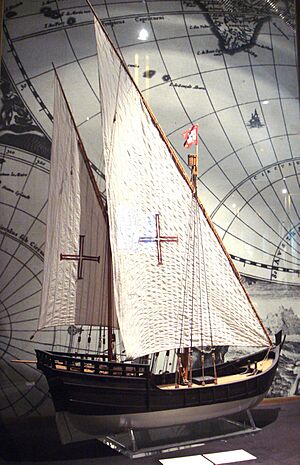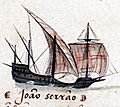Caravel facts for kids
A caravel (called caravela in Portuguese) was a small, easy-to-steer sailing ship. Sailors in Portugal developed this type of ship in the 1400s. The Portuguese used caravels to explore the coasts of West Africa and the Atlantic Ocean.
Caravels were fast and could even sail against the wind. This was thanks to their special triangular sails, called lateen sails. These ships were very important during the Age of Discovery in the 15th and 16th centuries. They helped explorers discover new parts of the world.
Contents
Where the Name Comes From
The English word "caravel" comes from the Portuguese word caravela. This word might have come from older Latin or Greek words for a type of boat. This suggests that the way caravels were built, called "carvel build," might have been used for a long time.
History of Caravels
The first caravels appeared in the 1200s along the coasts of Galicia (in Spain) and Portugal. These early caravels were used for fishing far from shore and for carrying goods along the coast.
They were small boats, often weighing 20 tons or less. Some records from the late 1300s suggest these early caravels were "open boats," meaning they didn't have decks. By the early 1300s, larger caravels (up to 30 tons) were mentioned in Biscay. These bigger ships were considered true ships, not just boats. Caravels were a common type of ship in Spain and Portugal for most of the 1400s.
How Caravels Were Designed
Caravels were lighter and faster than many other ships of their time. This made them very helpful for sailors.
Early caravels usually had two or three masts with lateen sails. Later types sometimes had four masts. The first caravels, like the caravela tilhlda from the 1400s, were typically between 12 and 18 meters (about 39 to 59 feet) long. They could carry about 50 to 60 tons of cargo.
These ships were designed to be very fast and easy to steer. However, they couldn't carry as much cargo as some other ships. For example, when Christopher Columbus set out on his famous journey in 1492, his flagship, the Santa María, was a larger ship called a nau. His other two ships, the Pinta and Niña, were smaller caravels. They were about 15 to 20 meters (49 to 66 feet) long and weighed around 60 to 75 tons.
Images for kids
See also
 In Spanish: Carabela para niños
In Spanish: Carabela para niños





